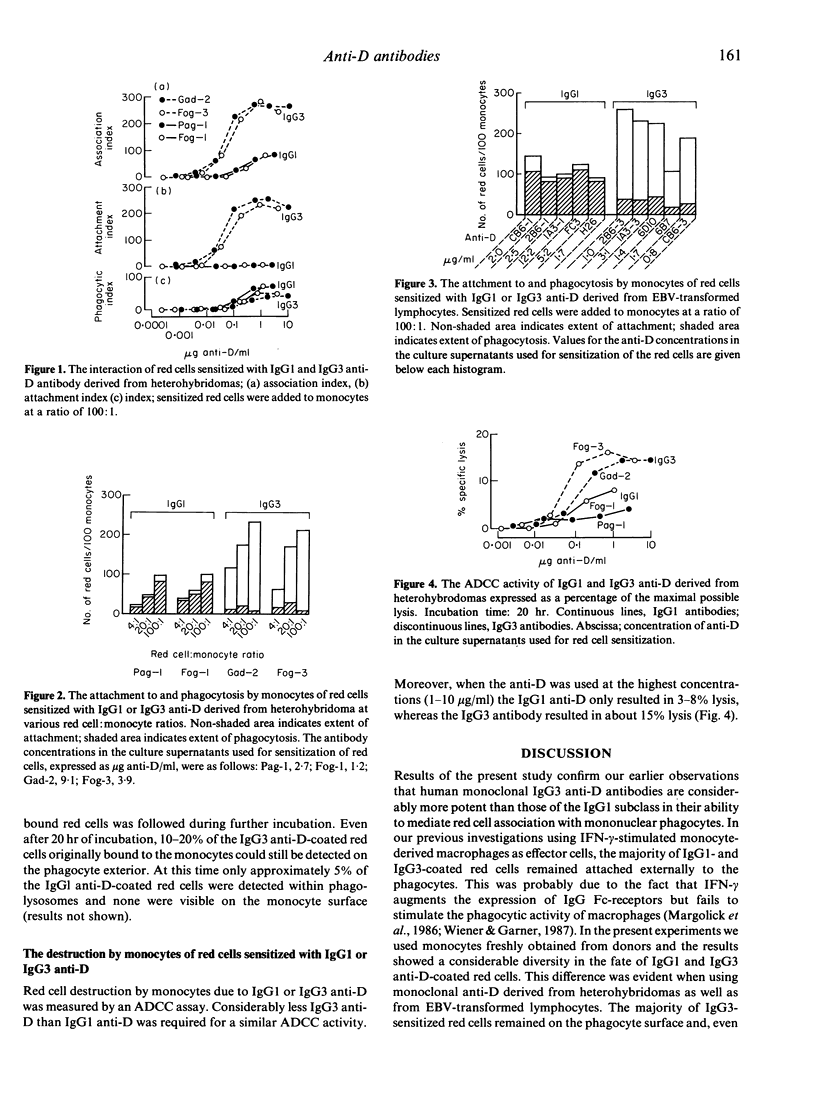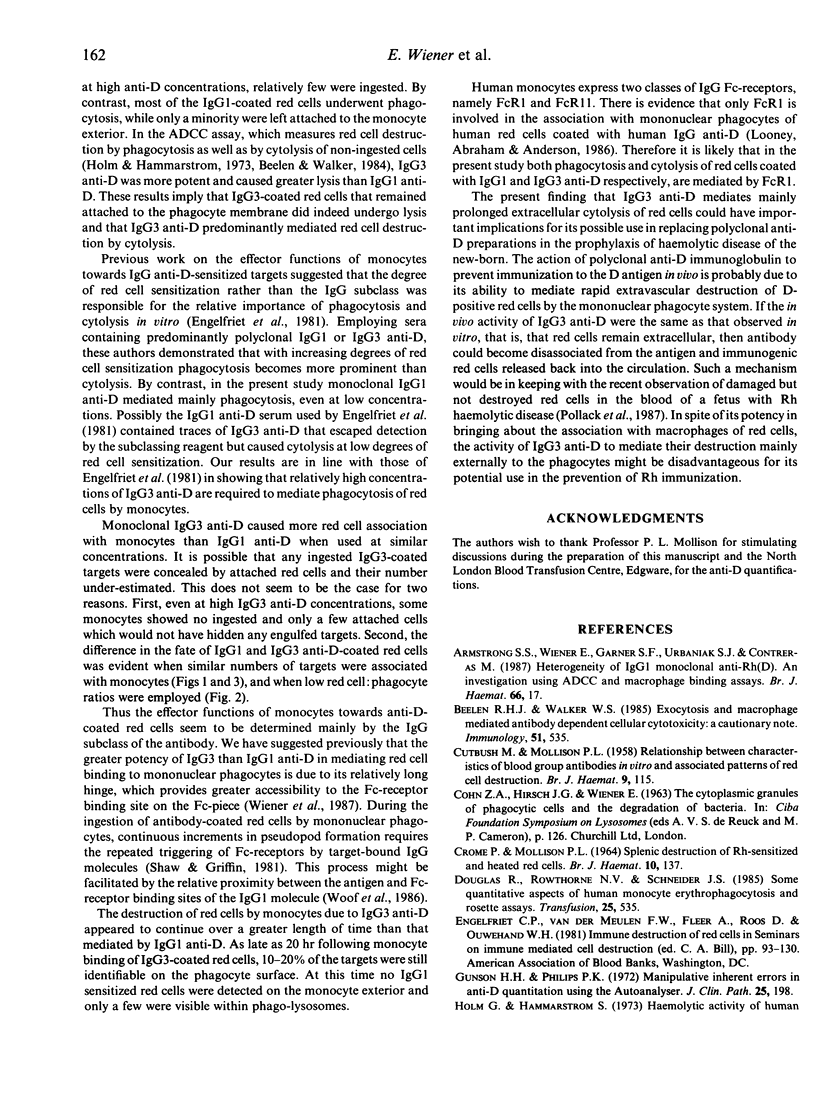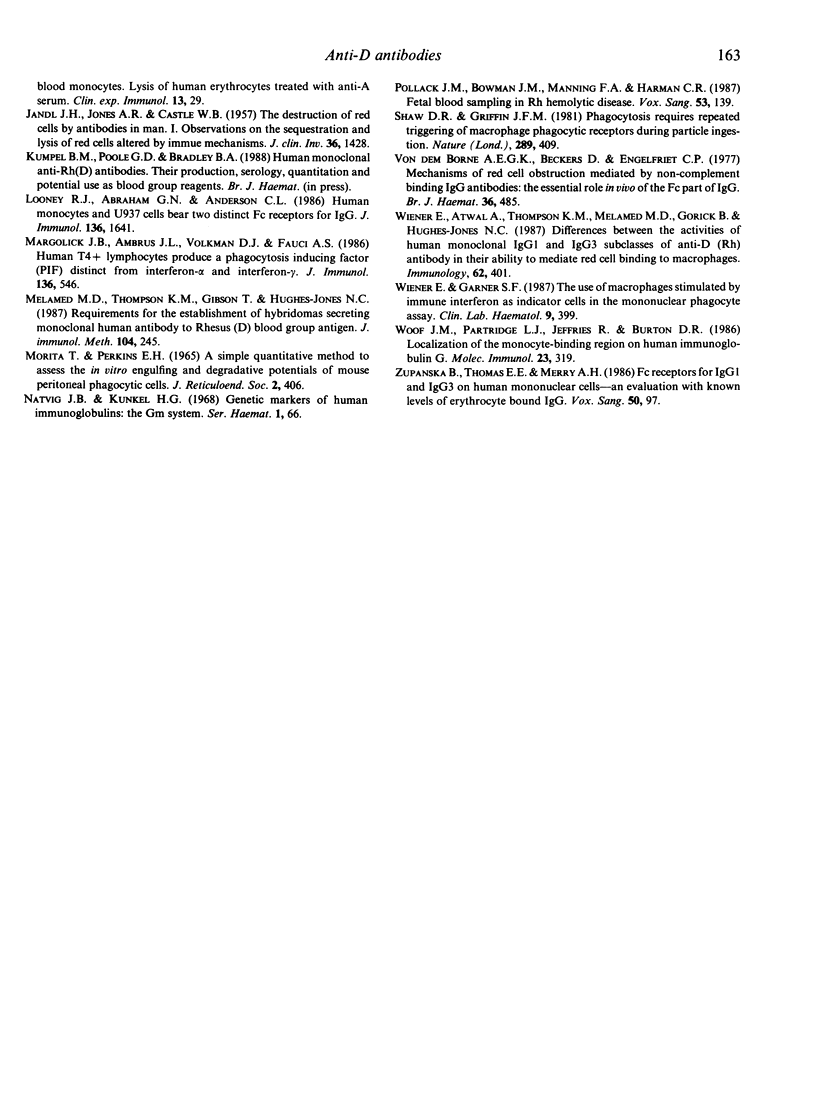Abstract
Seven IgG1 and seven IgG3 human monoclonal antibodies derived from heterohybridoma or Epstein-Barr virus-transformed lymphocytes and specific for the D antigen of the human Rh blood group system were tested for their ability to bring about red cell attachment to and phagocytosis by monocytes. The antibodies produced by the heterohybridomas were also investigated for their potency to mediate antibody-dependent cellular cytotoxicity (ADCC) by monocytes. When red cells were sensitized with any of the IgG1 anti-D antibodies, most of them were ingested by the phagocytes. By contrast, many of the red cells coated with any of the IgG3 antibodies remained attached to the monocyte surface while only few underwent phagocytosis. Some of the attached red cells remained on the phagocyte exterior for a considerable length of time. The ADCC activities of the IgG3 anti-D antibodies was greater than that of the IgG1 anti-D antibodies. The results mean that in vitro IgG1 anti-D mediates red cell destruction mainly by phagocytosis, while IgG3 anti-D causes their destruction predominantly by prolonged cytolysis. These differences between the effector functions of human monoclonal IgG1 and IgG3 anti-D antibodies might have important implications for their use in the prophylaxis of haemolytic disease of the new-born.
Full text
PDF




Selected References
These references are in PubMed. This may not be the complete list of references from this article.
- Beelen R. H., Walker W. S. Exocytosis and macrophage-mediated antibody-dependent cellular cytotoxicity: a cautionary note. Immunology. 1984 Mar;51(3):535–540. [PMC free article] [PubMed] [Google Scholar]
- CROME P., MOLLISON P. L. SPLENIC DESTRUCTION OF RH-SENSITIZED, AND OF HEATED RED CELLS. Br J Haematol. 1964 Apr;10:137–154. doi: 10.1111/j.1365-2141.1964.tb00689.x. [DOI] [PubMed] [Google Scholar]
- CUTBUSH M., MOLLISON P. L. Relation between characteristics of blood-group antibodies in vitro and associated patterns of redcell destruction in vivo. Br J Haematol. 1958 Apr;4(2):115–137. doi: 10.1111/j.1365-2141.1958.tb03843.x. [DOI] [PubMed] [Google Scholar]
- Douglas R., Rowthorne N. V., Schneider J. V. Some quantitative aspects of the human monocyte erythrophagocytosis and rosette assays. Transfusion. 1985 Nov-Dec;25(6):535–539. doi: 10.1046/j.1537-2995.1985.25686071425.x. [DOI] [PubMed] [Google Scholar]
- Gunson H. H., Phillips P. K., Stratton F. Manipulative and inherent errors in anti-D quantitation using the AutoAnalyzer. J Clin Pathol. 1972 Mar;25(3):198–205. doi: 10.1136/jcp.25.3.198. [DOI] [PMC free article] [PubMed] [Google Scholar]
- Holm G., Hammarström S. Haemolytic activity of human blood monocytes. Lysis of human erythrocytes treated with anti-A serum. Clin Exp Immunol. 1973 Jan;13(1):29–43. [PMC free article] [PubMed] [Google Scholar]
- JANDL J. H., JONES A. R., CASTLE W. B. The destruction of red cells by antibodies in man. I. Observations of the sequestration and lysis of red cells altered by immune mechanisms. J Clin Invest. 1957 Oct;36(10):1428–1459. doi: 10.1172/JCI103542. [DOI] [PMC free article] [PubMed] [Google Scholar]
- Looney R. J., Abraham G. N., Anderson C. L. Human monocytes and U937 cells bear two distinct Fc receptors for IgG. J Immunol. 1986 Mar 1;136(5):1641–1647. [PubMed] [Google Scholar]
- Margolick J. B., Ambrus J. L., Jr, Volkman D. J., Fauci A. S. Human T4+ lymphocytes produce a phagocytosis-inducing factor (PIF) distinct from interferon-alpha and interferon-gamma. J Immunol. 1986 Jan;136(2):546–554. [PubMed] [Google Scholar]
- Melamed M. D., Thompson K. M., Gibson T., Hughes-Jones N. C. Requirements for the establishment of heterohybridomas secreting monoclonal human antibody to rhesus (D) blood group antigen. J Immunol Methods. 1987 Nov 23;104(1-2):245–251. doi: 10.1016/0022-1759(87)90511-4. [DOI] [PubMed] [Google Scholar]
- Morita T., Perkins E. H. A simple quantitative method to assess the in vitro engulfing and degradative potentials of mouse peritoneal phagocytic cells. J Reticuloendothel Soc. 1965 Dec;2(5):406–419. [PubMed] [Google Scholar]
- Pollock J. M., Bowman J. M., Manning F. A., Harman C. R. Fetal blood sampling in Rh hemolytic disease. Vox Sang. 1987;53(3):139–142. doi: 10.1111/j.1423-0410.1987.tb04937.x. [DOI] [PubMed] [Google Scholar]
- Shaw D. R., Griffin F. M., Jr Phagocytosis requires repeated triggering of macrophage phagocytic receptors during particle ingestion. Nature. 1981 Jan 29;289(5796):409–411. doi: 10.1038/289409a0. [DOI] [PubMed] [Google Scholar]
- Wiener E., Atwal A., Thompson K. M., Melamed M. D., Gorick B., Hughes-Jones N. C. Differences between the activities of human monoclonal IgG1 and IgG3 subclasses of anti-D(Rh) antibody in their ability to mediate red cell-binding to macrophages. Immunology. 1987 Nov;62(3):401–404. [PMC free article] [PubMed] [Google Scholar]
- Wiener E., Garner S. F. The use of macrophages stimulated by immune interferon as indicator cells in the mononuclear phagocyte assay. Clin Lab Haematol. 1987;9(4):399–408. doi: 10.1111/j.1365-2257.1987.tb00578.x. [DOI] [PubMed] [Google Scholar]
- Woof J. M., Partridge L. J., Jefferis R., Burton D. R. Localisation of the monocyte-binding region on human immunoglobulin G. Mol Immunol. 1986 Mar;23(3):319–330. doi: 10.1016/0161-5890(86)90059-3. [DOI] [PubMed] [Google Scholar]
- Zupańska B., Thomson E. E., Merry A. H. Fc receptors for IgG1 and IgG3 on human mononuclear cells--an evaluation with known levels of erythrocyte-bound IgG. Vox Sang. 1986;50(2):97–103. doi: 10.1111/j.1423-0410.1986.tb04854.x. [DOI] [PubMed] [Google Scholar]
- von dem Borne A. E., Beckers D., Engelfriet C. P. Mechanisms of red cell destruction mediated by non-complement binding IgG antibodies: the essential role in vivo of the Fc part of IgG. Br J Haematol. 1977 Aug;36(4):485–493. doi: 10.1111/j.1365-2141.1977.tb00988.x. [DOI] [PubMed] [Google Scholar]


